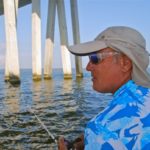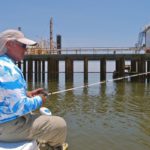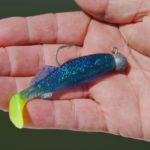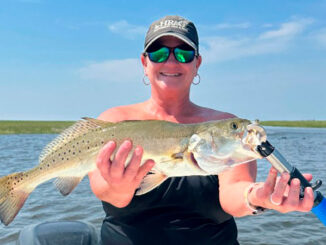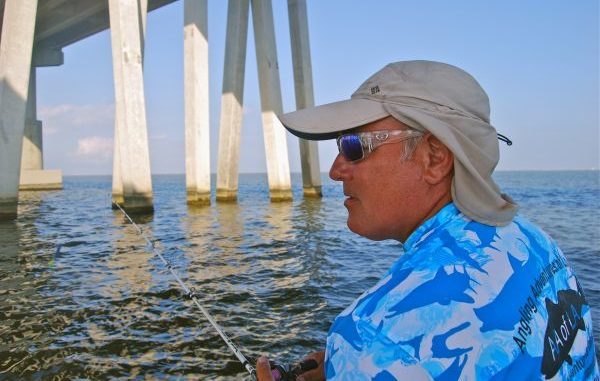
Just one bite can help Capt. Mike Gallo make a game plan to catch more fish
On a recent trip fishing the Interstate 10 twin spans over Lake Pontchartain, Capt. Mike Gallo repeatedly cast his favorite artificial lure against the bridge’s concrete columns, patiently waiting for what type of information the speckled trout would provide him that morning.
Gallo wasn’t just waiting for a bite as he worked a Deadly Dudley’s mojo mullet along the bottom — he was trying to determine exactly what kind of bite it was so he could maximize the catch for his clients, who were fishing with live shrimp on a drop-shot rig.
“For me, it’s like sampling. I learn so much with one bite,” said Gallo, who operates Angling Adventures of Louisiana from his lodge in Pirate’s Harbor. “Was it a hard aggressive bite, or was it a very soft, lethargic bite?”
When he’d catch a keeper, he’d instantly direct his customers to cast their live shrimp into that spot.
“A very hard aggressive bite makes me think there’s a bunch of them down there and they’re competing with one another for food. A very soft bite means he might be down there by himself, and he can eat at his leisure. I take all that into account: the time of year makes a difference and moon phases matter, too.”
In about the first 90 minutes of fishing, Gallo navigated his 24-foot Blue Wave into three different spots under the twin spans, and he practiced what he always preaches about not staying in one place too long.
“You want to look for clean moving water with baitfish in the area,” Gallo said. “Give it 15 to 20 minutes, fan-cast, and if nothing happens, move. Go find other clean moving water with the presence of bait.”
The group caught eight trout, six of which were keepers, but water wasn’t moving so Gallo headed to several platforms in Lake Borgne.
He hit pay dirt on the first stop, and his customers worked on a school of specks holding in the middle of a platform.
“Lake Borgne is a much smaller body of water, and you’re not trying to fish a bridge that’s five miles long,” Gallo said. “The structure that you’re fishing is smaller. We can go around one of those platforms with the trolling motor in 30 minutes.
“You can’t fish one of those bridges in 30 minutes.”
As fish were caught, Gallo quickly re-baited the hooks with live shrimp to keep the bite going.
“I’m hustling because I don’t want that school getting away,” he said. “I constantly want a line in the water. If I get on a real good bite with three people fishing, I’ll have four poles rigged and ready.
“One of them swings a fish in, I take the fish and the pole and hand him a pole with a shrimp on it and he’s back in the water. Then I’ll unhook you, throw the fish on the floor and hook another shrimp. The next guys swings a fish in, you do the same thing.You’re trying to keep that school there.”
Gallo said the speck bite so far this year seems like it’s still a few weeks behind schedule, and noted that his records indicate he started fishing with live shrimp last year on April 16.
This year, live shrimp weren’t available consistently until May 18.
The two-person group wrapped up the day with 35 specks, a redfish, a few drum and a couple of white trout.
“It does seem like trout fishing in Lake Pontchartrain is behind,” he said. “There’s trout in lots of locations, but not really any concentrations of trout.”
Gallo is hoping since the action started a bit later, it also might last a little longer than normal.
“It’s seems like it’s backed up by three weeks to a month, but at the same time, usually by the end of June we start to see Lake Pontchartrain numbers and percentages starting to dwindle, while Lake Borgne increases, but that only seems to last for maybe two or three weeks,” he said. “Then it seems the whole area is not very consistent for trout fishing at all.”
Gallo rigs up year-round with 40-pound Fins Windtamer braid, a lighter 20- to 30-pound mono or fluorocarbon leader and No. 2 VMC hooks.
“I don’t think our water is that clear that we have to worry about fluorocarbon versus mono,” he said.
But if you can get your hands on live shrimp in the next few weeks, Gallo said to do it.
“This time of year, live bait is a must,” he said. “There’s a difference in the fish hitting an artificial lure and figuring out it’s fake and not hitting it again, and a fish trying to eat that live shrimp,” he said. “If you don’t take it from him, he’s going to eat it. He’ll hook himself.
“That’s part of the reason I use a small hook. They can swallow it without even knowing it, and if it’s a small fish, I can unhook it without damaging it.”
